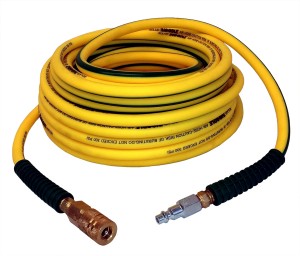CHOOSING THE RIGHT AIR HOSE
Choosing the right air hose may seem like a fairly straightforward decision. After all, it’s just an accessory to get air from point A (the air compressor) to point B (the tool), right? Well, if you’ve worked with pneumatic tools for a while, you’ve probably realized that there’s more to it than that. You might even have a solid list of preferences in mind when you step into the construction supply store to find a new one. For those new to the building trades, or for the casual DIYer, we’ve outlined the basics below.
The main factors to consider when choosing an air hose are the material it’s made of, the length required and the inside diameter. You’ll also want to be mindful of the work environment, type of tool being operated, distance from the air compressor and, of course, budget.
HOSE MATERIAL
Hybrid Hose – The hybrid blend of polyurethane, PVC and rubber allows hybrid hose to be extremely flexible and durable, even in frigid temperatures. If you’ve ever been frustrated by air hose that kinks and is generally difficult to unravel, this is the choice for you.
Polyurethane Hose – Sometimes referred to as poly hose, polyurethane air hose is considered an “all-around” option. It weighs less than comparable hybrid and PVC options, which is a factor you’ll appreciate after you’ve dragged it around a job site all day. It also stays flexible in most conceivable working temperatures.
PVC Hose – PVC hose is very durable and abrasion resistent. It’s considered to be the economical option. While not as flexible as the above varieties, it’s great when working in warm weather. It’s also easy to maneuver around corners and obstacles without getting hung up.
LENGTH
Typically, air hoses will be either 50- or 100-feet long, with a few exceptions. Most people will go for the 100-foot option because it allows them to maximize their distance from the air compressor. This is especially beneficial if it eliminates the need for an extension cord, which can be tough on electric motors if not sized properly.
There are some specific situations in which a 50-foot hose might be a better option. The obvious scenario would be when working in tight quarters. A not-so-obvious scenario would be when the CFM requirement of the tool being used is close to the output of the air compressor. When that’s the case, every little bit of air counts and a shorter air hose will help minimize frictional loss, thereby decreasing the chances of stair-stepped nails.
INSIDE DIAMETER
The most common inside diameters are 1/4- and 3/8-inch. Many people choose 1/4-inch hose because it’s lighter than the 3/8-inch variety. It’s easier to roll up, carry around and store. Of course, it doesn’t hurt that the price tag for 1/4-inch hose is lower than its 3/8-inch counterpart.
A wider inside diameter, however, can also have benefits. Like shorter lengths of hose, a wider inside diameter will help limit frictional loss.
OTHER CONSIDERATIONS
While the varieties listed above are popular among the building trades, they’re not the only types of air hose available on the market. At one time, rubber air hoses were pretty common. They are still available, but their weight makes them difficult to tow around the job site. Nylon recoil hoses are also fairly common, but are typically found in automotive and industrial applications. These are self-coiling and can be easily stored away when not in use, but do not do well in cold weather.











































